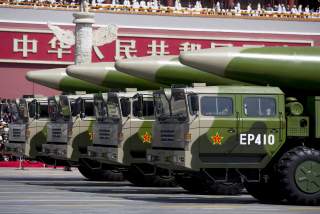The Navy Fears Russia and China Could Exploit a Dangerous Military Weakness
Killing U.S. military cargo and spy planes.
The U.S. Navy wants new, better ways to protect its large cargo and surveillance planes from increasingly sophisticated missiles threats from countries like China and Russia.
Earlier this month, the U.S. Naval Air Systems Command (NAVAIR) began soliciting bids from defense firms for new ways to protect “wide body” planes like the Lockheed C-130 Hercules. The wide body designation would also include planes derived from civilian aircraft, such as Air Force planes like the future Boeing KC-46 Pegasus aerial refueling airplane. In fact, the Request for Information—as the official solicitation is called—singles out the McDonnell Douglas DC-10 as one of the wide body planes it is interested in protecting. The Air Force is the only service that operates a plane based on the DC-10. Other planes that could fit this description include the E-6B airborne command and P-8 maritime patrol aircraft.
Recommended: The Fatal Flaw That Could Take Down an F-22 or F-35.
Recommended: Smith & Wesson's .44 Magnum Revolver: Why You Should Fear the 'Dirty Harry' Gun.
Recommended: 5 Best Shotguns in the World (Winchester, Remington and Beretta Make the Cut).
Currently, these types of planes, which are critical for America’s global reach, are protected using decoys like flares or the use of lasers or radio-frequency countermeasures that blind guidance systems. However, the growing sophisticated of some adversaries’ missiles make these self-defense mechanisms increasingly archaic. “With the increasing lethality and guidance mode complexity of long range missile threats, the US Navy is interested in exploring potential alternatives and/or adjuncts to more conventional electronic self-protection solutions,” the U.S. Navy said in soliciting the new bids.
NAVAIR is specifically interested in ideas to implement its Hard Kill Self Protection Countermeasure System (HKSPCS) concept. This envisions the planes themselves—or unmanned aerial vehicles (UAVs) escorts—carrying interceptors to destroy missile threats. It proposes three potential options for vendors. As Flight Global explains:
The first option calls for an internally mounted system with a total weight not exceeding about 1,040kg (2,300lb). The second option would be a pod mounted system weighing from 385-1,313kg and sized to kill four to 10 incoming missiles, factoring in the interceptor’s calculated probability of kill.
The final option would be to have UAVs escort the planes and have the drones equipped with interceptors to destroy the incoming missiles.
Flight Global also notes that the Air Force began working on a similar capability two years ago when it gave Raytheon up to $14 million to research and develop new missiles—like the miniature self-defense munition (MSDM). And, as The Drive has reported, independent of these efforts Northrop Grumman has patented its own system that appears to be similar to what the U.S. Navy is seeking. The patent describes the system, which is actually meant for stealth aircraft, as follows:
A missile defense system on an aircraft for destroying threats to the aircraft. The defense system includes at least on[e] miniature guided missile mounted in a launch tube on the aircraft, where the guided missile includes a target acquisition and seeker system. The system also includes at least one sensor on the aircraft for acquiring a target threat, and a controller on the aircraft receiving signals from the at least one sensor. The controller generates a fire control solution that is provided to the at least one guided missile that directs the guide missile once if is fired from the launch tube towards the target threat, and the seeker system on the guided missile acquires the target once it is launched from the aircraft so as to destroy the target.
Some of the adversary missiles the HKSPCS concept is being designed to defeat were recently profiled in an article in Bloomberg News. “Some of China’s biggest strides are coming in air-to-air missiles, the weapons that for one or two million dollars can destroy a $150 million aircraft,” the article noted. “That’s a cost efficient way of trying to level the playing field with the U.S.” One such missile is China’s PL-15, which was first debuted in September 2015. This beyond visual range air-to-air missile (BVRAAM) reportedly has a range of 150–200 km and terminal maneuverability. Beijing is also working on ramjet engines that could further extend the range of its BVRAAMs. The P-15 also has active electronically scanned array radar that makes it resistant to some of the counter measures current wide-body planes employ.
As the Bloomberg article also notes, China is also working on a new missile provisionally called PL-XX. According to estimates by the always excellent Eastern Arsenal blog, this missile could be categorized as very long range air-to-air missile (VLRAAM) with ranges further than 300 kilometers (186 miles) and possibly as far as 300 miles. Furthermore, according to Jeffrey Lin and P.W. Singer—the authors of Eastern Arsenal—the PL-XX could have speeds of Mach 6, “which will increase the no escape zone (NEZ), that is the area where a target cannot outrun the missile, against even supersonic targets like stealth fighters.” The PL-XX also boasts exceptionally large active electronically scanned (AESA) radar. Many believe that missile is specifically intended to destroy wide body, slow moving planes like airborne control and early warning jets.
Zachary Keck is a former managing editor of the National Interest and the official foreign-policy advisor of the 06010. He tweets at @ZacharyKeck.
Image: Reuters

